Chemi-Verse™ PARP7 Assay Kit
The Chemi-Verse™ PARP7 Assay Kit is designed to measure the activity of PARP7 (poly-(ADP-ribose) polymerase 7) for screening and profiling applications. The PARP7 assay kit comes in a convenient 96-well or 384-well format, with enough recombinant purified PARP7 enzyme (amino acids 400-657), histone mixture, NAD+, a ribose-binding agent and PARP assay buffer for 100 or 400 enzyme reactions.

Figure 1. Chemi-Verse™ PARP7 Assay Kit schematic.
Histone proteins are coated on a 96-well or 384-well plate. Next, a biotinylated NAD+ substrate is incubated with the PARP7 enzyme in an optimized assay buffer. The plate is then treated with an ADP-ribose specific binding agent and a secondary HRP-conjugated antibody. ELISA ECL substrate is added to produce chemiluminescence that can be measured using a chemiluminescence reader. The chemiluminescence signal is proportional to PARP7 activity.
Need us to run inhibitor screens or profile your compounds against PARP7? Check out our PARP/PARPTrap™ Screening Services or DNA Replication and Repair Screening Services.
- 1x PBS (Phosphate Buffer Saline) Buffer
- PBST Buffer (1x PBS, containing 0.05% Tween-20)
- Luminometer or microplate reader capable of reading chemiluminescence
- Adjustable micropipettor and sterile tips
- Rotating or rocker platform
96 reactions
| Catalog # | Name | Amount | Storage |
| 80527 | PARP7, FLAG-Tag* | 2 µg | -80°C |
| 52029 | 5x Histone Mixture | 1 ml | -80°C |
| 50 µM NAD+ | 250 µl | -80°C | |
| PP-16-2 Assay Buffer | 1 ml | -20°C | |
| 79743 | Blocking Buffer 3 | 2 x 25 ml | +4°C |
| 0.5 M DTT | 200 µl | -20°C | |
| Ribose-Binding Reagent 2-D | 10 µl | -80°C | |
| 52131H | Secondary HRP-Antibody 2 | 10 µl | -80°C |
| 79670 | ELISA ECL Substrate A (translucent bottle) | 6 ml | Room Temp |
| ELISA ECL Substrate B (brown bottle) | 6 ml | Room Temp | |
| 79837 | 96-well module plate | 1 | Room Temp |
*The concentration of the protein is lot-specific and will be indicated on the tube
384 reactions
| Catalog # | Name | Amount | Storage |
| 80527 | PARP7, FLAG-Tag* | 2 x 2 µg | -80°C |
| 52029 | 5x Histone Mixture | 2 x 1 ml | -80°C |
| 50 µM NAD+ | 2 x 250 µl | -80°C | |
| PP-16-2 Assay Buffer | 2 x 1 ml | -20°C | |
| 79743 | Blocking Buffer 3 | 2 x 25 ml | +4°C |
| 0.5 M DTT | 2 x 200 µl | -20°C | |
| Ribose-Binding Reagent 2-D | 2 x 10 µl | -80°C | |
| 52131H | Secondary HRP-Antibody 2 | 2 x 10 µl | -80°C |
| 79670 | ELISA ECL Substrate A (translucent bottle) | 2 x 6 ml | Room Temp |
| ELISA ECL Substrate B (brown bottle) | 2 x 6 ml | Room Temp | |
| 78188 | 384-well white plate | 1 | Room Temp |
*The concentration of the protein is lot-specific and will be indicated on the tube
PARP7, also known as poly-(ADP-ribose) polymerase 7 or NAD+ ADP-ribosyltransferase 7, is part of the PARP family. ADP ribosylation, which is the addition of an ADP-ribose to a protein, is a reversible post-translational modification of proteins mostly involved in the DNA Damage Response (DDR) pathway. Mono-ADP-ribosylation (termed MARylation) is the addition of a unit of ADP-ribose. PARP7 is a negative regulator of nucleic acid sensing in cancer cells. Tumor cells contain cytosolic DNA as a reflection of defects in DNA repair and must repress responses coming from the adaptative immune system. PARP7 is an AHR (aryl hydrocarbon receptor) regulated gene that inhibits STING (stimulator of interferon genes) and IFN-I (interferon type I). RBN-2397 is a pyridazinone-based PARP7 inhibitor that results in STING-dependent and IFN-I activation and leads to cancer cell death in vitro and it is currently under clinical trial. The development of PARP7 inhibitors is thus a promising area in cancer research.
Sanderson D., et al., 2023 Cell Chemical Biology 30(1): 43-54.



